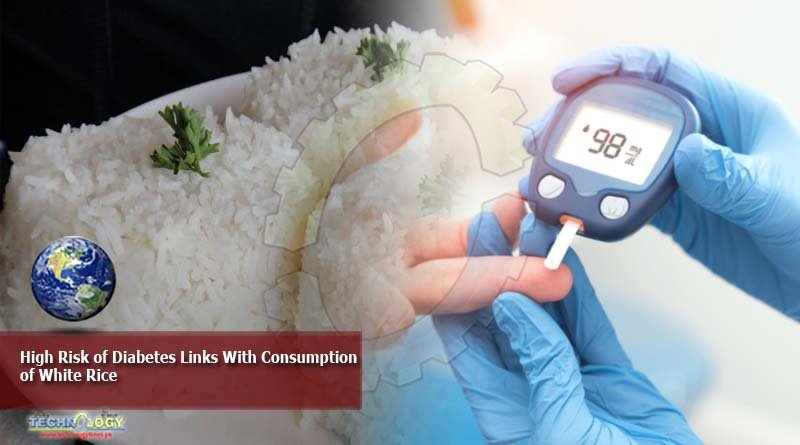An analysis of over 1,30,000 adults from 21 countries over nearly a decade has linked white rice as an indication of a high risk of diabetes with the consumption of white rice . The risk is most prominent for the South Asian population, according to findings from a new, large-scale, long-term study.

The study was an international collaboration between researchers from various countries — including India, China, and Brazil — in Asia, North and South America, Africa and Europe.
Led by Bhavadharini Balaji of the Population Health Research Institute, Hamilton Health Sciences and McMaster University, Canada, the study was a part of the institute’s Prospective Urban Rural Epidemiology (PURE) project.
White rice is milled rice that has its germ (the part that sprouts), bran (hard outer layer), and husk (outer covering) removed. The polishing of rice further results in a bright and shiny appearance. While white rice has an appealing appearance and can be stored longer, the milling and polishing process remove nutrients such as vitamin B.
White rice has been linked to an outbreak of beriberi in Asia, caused by vitamin B-1 deficiency. It also causes the blood sugar levels to spike upon consumption due to its high glycemic index.
Globally, 42.5 crore people currently have diabetes, and this number is expected to increase to 62.9 crore by 2045, according to the International Diabetes Federation.
Studies have alluded to risk of diabetes associated with white rice for a few decades now, although findings have been contradictory. A 2012 study found that each extra serving of white rice increased the risk for diabetes by 11 per cent.
However, findings change depending on which country studies were conducted in. For example, a study of over 45,000 participants in Singapore found no substantial increase in diabetes was associated with white rice consumption.
Most such studies were limited to single countries. To beat this barrier, the authors of the new study extended it to 21 nations — Argentina, Bangladesh, Brazil, Canada, Chile, China, Colombia, India, Iran, Malaysia, ‘occupied Palestine territory’, Pakistan, Philippines, Poland, South Africa, Saudi Arabia, Sweden, Tanzania, Turkey, United Arab Emirates, and Zimbabwe.
However, the South Asian population seems to show a pattern with white rice consumption and diabetes, despite a number of other lifestyle factors that increase the disease risk.
“South Asians are genetically more predisposed to get diabetes, so there are both lifestyle as well as biological reasons for the high diabetes incidence,” said Bengaluru-based physician Dr Gowri Kulkarni.
To understand the link between white rice and diabetes in South Asia, the researchers compared the data from India, Bangladesh, and Pakistan with the rest of the world.
The study involved 132,373 individuals between the ages of 35 and 70, from these 21 countries, who were monitored for nine and a half years. Of these, 6,129 developed diabetes over the course of the study.
Participants were considered if they consumed more than one cup or 150g of cooked rice a day. Overall, the average white rice consumption was 128g a day among the study participants.
However, the team found that the highest consumption of white rice was seen in South Asia at 630g a day, followed by South East Asia at 239g and China at 200g per day. High consumption of rice resulted in lower consumption of other foods like wheat, fibre, red meat, and dairy products.
Carbohydrates make up nearly 80 per cent of calories consumed in many South Asian countries. Since the 1970s, carbs have become increasingly polished and refined as well, losing a lot of nutrition in the process.
Rapid urbanisation and economic development, especially in low- and middle-income countries, have led to a dramatic change in dietary intake and increased physical inactivity, which are related to the obesity epidemic.
Talking about the findings, Mumbai-based nutritionist Priya Kathpal said, “I wouldn’t say every white rice-eating family would have a diabetic person in their family… A lot depends on the quantity of rice eaten, what it’s eaten with, and how frequently.”
China and India are two of the world’s largest countries where rice is the staple food. Both also lead in the incidence of diabetes. However, the researchers found that there wasn’t a significant association with white rice consumption and diabetes in China.
There could be many reasons for this, apart from other lifestyle factors. The scientists believe that the kind of rice the Chinese eat (sticky rice) could make a difference.
In India, studies have shown that during the last four to five decades of replacing hand-pounded rice with industrially milled white rice, the prevalence of diabetes in urban areas in India increased from 2 per cent in the 1970s to 25 per cent in 2015, and in rural areas from 1 per cent to 14–16 per cent, respectively. White rice is considered to be one of the many main drivers of the trend, which followed improved socioeconomic growth and lifestyle modifications.
Studies have shown that substituting white rice with unpolished brown rice decreases the glycemic response by 23 per cent and the fasting insulin response by 57 per cent in overweight Asian Indians, but consumers do not tend to prefer brown rice due to its inconvenience of longer cooking duration, greater chewing difficulty, and lack of visual appeal.
“Several patients that I’ve asked to switch to brown rice have faced difficulty, as everyone’s grown up eating white rice,” said Kathpal.
“Taste is a huge factor, and brown rice often doesn’t taste the same as white with vegetable curries and dals. Sometimes, white rice alternatives like even millets can be more expensive or not as easily available too,” she said.
Doctors and dieticians are hesitant to recommend diets that are more expensive and less easily available even if they are healthier, as patients tend not to adopt them successfully.
“A daily diet should always be easy to maintain and easily available. Only then can it be sustainable,” said Kulkarni. “Indians in general have poor protein intake in diet, and this has to do with available resources and choices. Most calories are from carbohydrates as they are cheap.”
According to the researchers, in countries where rice is consumed the most or as a staple, the risk of increased diabetes among the public can be lowered by substituting white rice with alternate forms of healthier rice versions and adding more legumes or pulses to food.
Originally published by The Print
